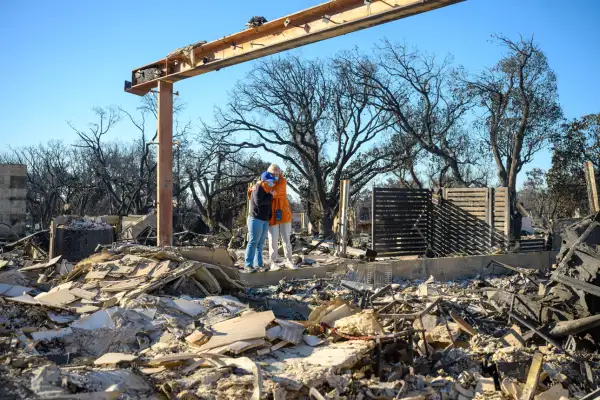Picking Up the Pieces: How Homeowners Move Forward After Natural Disasters

The recent California wildfires may be disappearing from the news cycle, but displaced homeowners are still facing a major challenge: recovering from the loss of much more than just a house.
They’re not alone. Thousands of homeowners lose their property to natural disasters like hurricanes, floods and wildfires every year. According to the National Oceanic and Atmospheric Administration, 73 separate billion-dollar disaster events caused more than $460 billion in damages between 2022 and 2024. And while many headlines focus on property losses and insurance shortfalls, these events continue to impact the lives of those affected long after the media attention fades away.
Just ask Mike Yurochko, CEO and founder of Loti, a company that provides resources to help disaster victims during the recovery and rebuilding process. He was horrified when he watched a live stream of firefighters battling a blaze at his family home in Sonoma County, California, as the Kincade fire tore through the area in October 2019. Looters picking through what was left in the weeks after the fire was out didn’t help matters, either.
Seeing your home damaged or destroyed — especially when you’re unable to intervene — takes a huge emotional toll, quickly followed by what Yurochko says is the “sheer fear of what happens next.”
Homeowners insurance after a disaster
Homeowners insurance is meant to help folks recover from these losses, but even if you’re fully insured, rebuilding could take years. In the meantime, you likely have more pressing matters to attend to.
Finding safe housing is the immediate concern. Many insurance policies provide Additional Living Expenses (ALE) coverage, which can pay for temporary rent, pet boarding and other monthly costs for a specific amount of time. For many, it's a good idea to start filing insurance claims as soon as possible so you can start receiving payouts quickly.
However, these are paid as reimbursements after the fact, so you’ll need to have cash on hand to cover costs for things like rent, food, and the replacement of personal items like clothes and toiletries. If you are under- or self-insured, these expenses may have to come out of your emergency savings. You might also be on the hook for property taxes and mortgage payments if your lender isn’t offering some form of relief.
“All around, there’s a lot of financial ripple effects there . . . that can affect your financial security down the road,” says Hanna Horvath, a certified financial planner who specializes in the psychological aspects of money management.
Some help is already being offered to mortgage holders affected by the California fires. Over 270 financial institutions, from state-chartered lenders to national banks and credit unions, have agreed to offer a 90-day forbearance period on mortgage payments for homeowners in designated fire areas. The California legislature has also introduced a bill that would prohibit foreclosures and give homeowners the option of freezing mortgage payments without incurring a penalty for up to a year.
For victims of catastrophic weather events like the California wildfires and Hurricane Helene, natural disasters pose a serious financial threat that can take years to rebound from — whether they are insured or not.
For instance, depleting your savings could force you to go into debt, dip into your retirement savings or use funds earmarked for other purposes. Plus, you won’t have home equity to rely upon if you need cash. Equity loans and lines of credit rely on the appraised market value of your home. Fire-damaged or destroyed homes are likely to suffer a loss in resale value, and you may no longer have enough equity to take out a loan.
Under these circumstances, many people turn to disaster assistance funds set up by state and federal governments and other charitable organizations like the American Red Cross or United Way. Or victims may set up GoFundMe pages for financial support.
Rebuild or sell?
According to Kori Sassower, principal agent and founder of the Kori Sassower real estate team, homeowners whose properties have been damaged in a natural disaster generally have two choices: clean up and rebuild, or cut the losses and sell the land.
In a 2021 poll conducted by NPR, more than two-thirds of all homeowners said they would decide to stay and rebuild after a major disaster. After all, their home is the place they chose to raise a family or enjoy their golden years. But rebuilding, especially after a catastrophic event, can turn into a drawn-out process that drains your resources.
Even though your property may have been insured, the claims process typically takes time. You likely won’t receive a lump sum payment but instead a series of payments as you rebuild your home and replace lost property. According to the National Association of Insurance Commissioners, most claims are fully paid within 18 to 24 months.
If you have losses covered under different policies, you will have to submit separate claims. Flood insurance, for example, is typically a separate policy from your homeowners insurance and has its own claims process. Having to submit claims under separate policies can extend the time you may have to wait.
Under the best circumstances, a home takes six months to a year to build. However, after a natural disaster, everything from building supplies and appliances to contractors and labor will be in short supply. Because demand is heavier than usual, rebuilding could take several years. According to Yurochko, only 40% of the homes lost in the Kincade fire have been rebuilt. His own family home took three and a half years to rebuild.
“We were paying for all those repairs and remediation out of our pocket,” Yurochko says. “We didn't get reimbursed from insurance until the very end.”
During the time it may take to rebuild, you’ll be responsible for making mortgage and insurance payments, taxes, rent (if the ALE runs out before the home is completed) and replacement of items not covered by your policy.
Other homeowners may consider selling the property and starting anew somewhere else. But this option also has some financial repercussions.
According to Sassower, in order to sell a flood-, storm- or fire-damaged property, it has to be insurable — meaning that the potential buyer can still obtain homeowners insurance on the property (this is a requirement if the home is being purchased with a mortgage). If the property is too damaged and has to be razed, the other option is to sell the land, which may not be as attractive to most buyers.
You’ll also take a big hit on the price. Depending on the amount of damage, Sassower says you may have to sell the home at a 20% to 80% discount of the original value. If the property takes a while to sell, you’ll still be responsible for paying the mortgage and other costs associated with the home.
These are just some of the difficult decisions homeowners who live in high-climate risk areas have to face. Climate risks are also quickly becoming a prominent factor in homebuying decisions as the risk of damages from storms, fires and floods increases over time.
“One can reasonably assume that these kinds of disasters will continue to happen [and] continue to be more catastrophic in the future,” Horvath says. “It’s very important to understand how you’re covered and where you may need to beef up your savings.”
More from Money:
7 Best Homeowners Insurance Companies
Why California’s Wildfires Could Make Your Home Insurance Pricier — Even if You Don’t Live There

